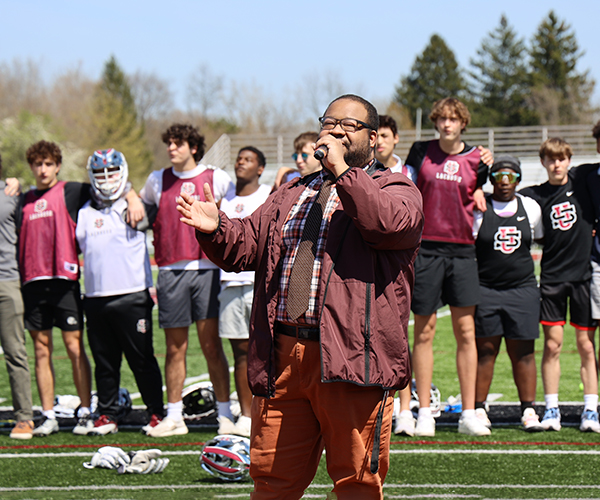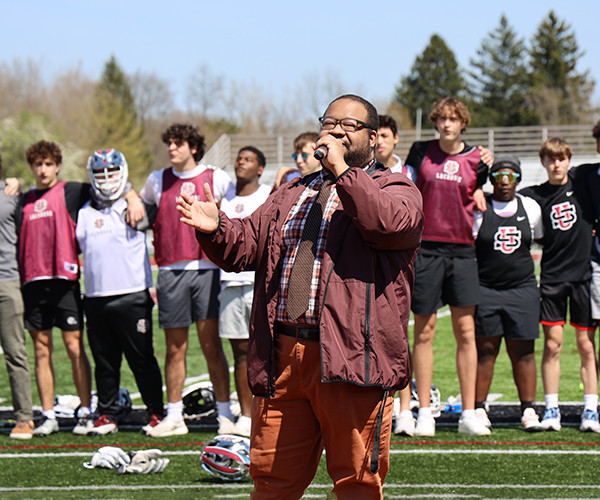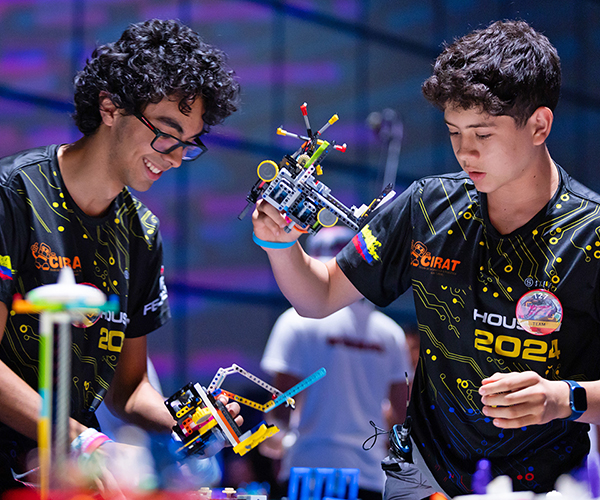It's just before 2 p.m. on a sunny winter Friday, and many of high school senior Jordan Doll's friends are in a classroom, sitting behind a desk, listening to a teacher at the front of the room.
But Jordan is in the crowded upstairs living room of an old mansion in Cleveland's University Circle, watching a video of a crime show. When the woman on the screen admits to murdering her husband with poison, the entire room erupts in laughter and applause.
This is Jordan's classroom — no lined-up desks or lecturing teachers to be found. Instead, the entire four grades are sitting on the floor, watching the mock-CSI video that some of Jordan's classmates produced to demonstrate what they learned about forensic science during a two-week intensive study program.
Enrolling as a freshman in Cleveland's Montessori High School the first year it opened was a big risk for Jordan, who had only experienced the traditional classroom setting at Roxboro elementary and middle schools in Cleveland Heights.
But after two years, Jordan wondered if she was missing something by not going to a traditional school and enrolled in Cleveland Heights High School.
After just one academic quarter at Heights High, Jordan returned to Montessori High School, where she will graduate in May.
And for a little while she questioned if she was a quitter — or a risk-taker.
"A lot of times people define risk as being flaky, especially in teenagers," she says.
But when she returned to Montessori, staff and classmates welcomed her back without questions.
"Most high schools would tell you that you did something wrong," she says. "But one good thing about this school is that it's really not judgmental."
Jordan says the school creates a level of comfort that allows for risk-taking inside and outside the classroom.
After the applause for the video dies down, Jordan heads to an internship at the Cleveland Museum of Art, even though many of the students have another afternoon class.
In today's competitive academic environment, many students become afraid to try anything out of the norm that might get them off track from landing in the best colleges. Take a risk, and you could fail.
But that's beginning to change.
The recognition of risk-taking and risking failure as a learning process is changing how students are being taught today, even in schools with a traditional curriculum.
That's why risk-taking is being recognized as a 21st-century skill that will be linked with a new rigorous college- and career-ready curriculum when it is integrated into all Ohio schools by 2014. Other key skills include digital-age literacy, inventive thinking that includes creativity and self-direction, effective communication (including collaboration) and high productivity.
"The classroom that sets up failure as an expected result and a result that you get early in the learning process is a healthy classroom," says Larry Goodman, head of The Ratner School in Pepper Pike.
The Ratner School, which serves students in preschool through eighth grade, uses the Montessori philosophy in its preschool and components of the philosophy in lower grades while slowly moving toward a more traditional classroom environment.
The Montessori philosophy builds on the idea of intrinsic motivation to learn.
"Risk-taking and failure look different when you're intrinsically motivated," says Goodman. "Failure is not a reflection on you. • You keep working at it. A risk that has gone bad actually acts as encouragement to keep going."
Lisa Damour, a clinical psychologist and director of the Center for Research on Girls at Laurel School, points to the work of Stanford psychologist Carol Dweck as a key resource for understanding how risk-taking impacts student success.
In her book Mindset, Dweck talks about growth and fixed mindsets. In a growth mindset, people believe they develop through hard work and that their brains and talent are just a starting point. In a fixed mindset, people believe their talent and intellect is a fixed trait that can't be further developed.
"Failure is good for those who have a growth mindset and think that failures are great because they show you what you still need to learn," explains Damour. "They're not good for students or families who have a fixed mindset and think that failure is really humiliating and shows what your kid can't do."
The best teachers or schools bring that growth mindset into a classroom and set up a safe environment that allows for making mistakes.
Marissa Covelli, a seventh-grade English teacher at Avon Middle School, uses fun and humor to get students comfortable with their own creativity and risk-taking.
"Putting yourself out there is what my class is all about," says Covelli. "My kids love to come to class because they don't know what's going to happen next. We don't sit and do worksheets all day. I always have something up my sleeve."
For example, in a lesson she gave on persuasion, Covelli had students create commercials about objects she brought in, such as doggie breath mints or an empty bottle of Gas-X.
When the class read Charles Dickens' A Christmas Carol, she brought in a fake fireplace and hot chocolate. The students sat on the floor to read it out loud.
When they read The Giver, Covelli wore an old person's mask so they could re-enact the "ceremony of 12" from the book. And when they studied the book Running Out of Time, in which a girl thinks she's living in the 1840s but discovers it's really 1996, they played the game Taboo to learn what it's like to describe something when you have a limited vocabulary.
Covelli, a first-year teacher, was a student of William Kist at Kent State University. He says she's an innovative teacher, but thinks that's a rarity in most schools today.
The idea of "teaching to the test" puts restrictions on teachers, says Kist, an associate professor in the School of Teaching, Learning and Curriculum Studies at Kent State University. Lack of innovation in a teacher leads to lack of innovation in a student.
"Kids are sitting in rows in desks, listening to the teacher talk, and then on Friday, they take a test, which is often set up to be a memorization test of facts," says Kist. "I don't think teachers are encouraged to try new things, and that trickles down to students, who increasingly see school as just a ticket to the next station."
Kist says the best teachers build choice into the curriculum by, for instance, giving students several project choices or different ways to approach a project, rather than hemming them into to a single, right way.
The rote and routine learning follows students into Kist's college classroom.
"When I pass out my syllabus at Kent State, students go through it to see what are the assignments they need to get an A, instead of asking, •What am I going to learn in this course?' or •How am I going to grow?' or •How am I going to take risks?' " he says. "They've grown up in a system where the whole point of school is to get good grades and go to college."
First-year teacher Katie Christo experienced the same thing this year when she began teaching eighth grade at Massillon Middle School.
"It was really shocking because anything I'd give them, they'd ask, •Is this being graded?' " Christo says. "The focus has always been on the grade, and that's been a challenge, trying to change their way of thinking to realize that doing it is the important part, and it shouldn't really matter if that specific assignment is graded."
Mike Waski, a math teacher at Montessori High School, sees the focus on grades from students who come from traditional educational backgrounds.
"I'll give a lesson and say, •Here's three options,' and they'll say, •Which one is right?' " Waski says.
Montessori High School does give grades because students end up with an International Baccalaureate diploma, but teachers don't grade every paper or project.
While it's tough to get completely away from grades — after all, colleges demand them — some teachers are using them less as an assessment tool.
Jon Barker, a math teacher at St. Ignatius High School, has cut back on testing.
"We still have the tests because they have to show me they've learned from this experience, but I don't do it as much because I feel like the days when I would have tested can be spent practicing in groups," he says.
The biggest change he's made in his classroom is to go to tables so the boys can work on problems together and help each other. Besides learning math, the boys are learning teamwork and collaboration, both 21st-century skills.
"It bred an atmosphere where you tried to help each other," says George Bashour, a St. Ignatius senior and student council president, who took Barker's calculus class last year.
Bashour also appreciated Barker's style, which taught higher level thinking skills, a big change from the usual math teacher routine of standing at the board doing problems for the students.
"He's not teaching you the formula, but he's teaching you the concept behind it," Bashour says.
Teamwork contributes not only to student learning but also to a cohesiveness in a school that gives students a safe atmosphere in which they feel comfortable taking risks. Carol Lockhart, principal of Cleveland Early College High School at John Hay, says bringing her teachers together in teams has radically improved her school and helped the students.
In fact, Early College High School has 100 percent graduation and college admission rates — unheard of for a school that has all its students on free or reduced lunch. Within Cuyahoga County, it ranks third on the Performance Index on the Ohio Graduation Test, behind Solon and Rocky River.
Resources are minimal for Early College High School, part of the Cleveland Metropolitan School District, but Lockhart believes best practices don't require funding.
Instead, she has built a foundation of collaboration among the teachers that trickles down to the students.
"We remind teachers that we are not educating students the way they were taught," Lockhart says. "We can't do that. Our students are in the 21st century. So if I get the teachers engaged in their own learning, they can get the students engaged in their learning. It's a win-win."
At Early College High School, Lockhart gives affirmations to students and teachers whenever she gets a chance. One of her favorites is: "A mind that is challenged by something new never returns to its old dimension." She stresses that life and education are a journey.
"Failure is part of the journey," Lockhart says. "But if you repeat the failure, you haven't learned anything from it. I don't want to see anyone fail, but I want to make sure that if they fail along the journey that the support is in place to help them become redeemed in some way."



